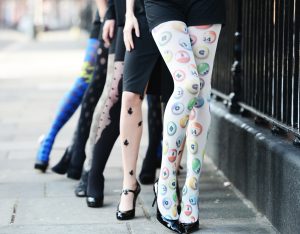The process of making hosiery has come a long way, and new advancements in fibre blending, dyes and manufacturing are improving all the time. Here you can learn about commonly used fibres used for hosiery, as well as the newer fibres that are becoming more popular.
Acrylic is a highly durable man-made fibre that provides warmth and softness and has good abrasion resistance. It is light weight and provides ease of laundering. Hosiery made of acrylic holds brighter and more brilliant colours than natural fibres.

Angora is the soft hair of an Angora rabbit. Used with other fibres, it provides a lot of comfort, warmth and has a fluffy look. Check out our Pretty Polly Angora Opaque Tights.
Bamboo fibres are taken from the natural, fast-growing bamboo plant. It is softer and more breathable than cotton and has a natural sheen to the surface, so it almost feels like silk or cashmere. Bamboo is hypoallergenic and very durable, making it a luxury choice for hosiery.
Cashmere is a fibre from the soft hair of a Cashmere goat. It provides natural, light-weight insulation with bulk and is considered a luxury fibre, mostly because of how soft and comfortable it is.
Cotton is a lightweight, moisture-absorbing fibre. It’s breathable, washable and durable. Cotton is also surprisingly warm, so can be worn all year round. Cotton is grown all over the world, but droughts, pests and the weather can impact production, sometimes driving up the price. Cotton fibre is gathered from around the seeds of the cotton plant and is 90% cellulose. Check out our Tiffany Quinn Spot Cotton Tights.

Elastane, Lycra and spandex all refer to the same style of synthetic fibre made from polyurethane. Spandex is the commonly used term in the U.S., which was marketed under brand name Lycra, while the term elastane is used worldwide. First produced by DuPont in 1959, the fibre has elastic properties so it is often used in place of rubber. Used with other fibres, it provides elasticity, comfort and a close fit, which makes it a common choice in hosiery.
Flax is one of the oldest fibre crops in the world. Flax fibre is extracted from the skin of the stem of the plant and is very soft, lustrous and flexible. It is stronger than cotton but less elastic.
Lurex is a synthetic fibre that incorporates a glittering metallic thread. It is often used for detailing in intricate hosiery patterns.
Modal is a natural fibre, typically made from beech trees. It’s more water-absorbent than cotton and holds on to color better. Check out our Pretty Polly Modal Opaque Tights.

Mohair is the long, soft, silky hair of the Angora goat. It is stronger than wool and dyes more easily than any other specialty hair fibre. This makes it a luxury fibre.
Nylon is a very strong, versatile, hard-wearing fibre. Hosiery made of nylon can be thin and silky or bulky and highly elastic. Nylon is often used with other fibres in blends to give added stretch or to improve durability. Check out our 100% Nylon Baci Diamond Patterned Jacquard Tights.
Polyamide fabric, also known as nylon fabric, is made of plastic. Polyamide fabric, like polyester fabric, is a man made polymer. It is manufactured through a chemical process. Check out our Charnos Pearl Back Seam Bridal Tights.
Polyester and stretch polyester are two water-repelling fibres that are known for their durability and are extremely colourfast for vivid colouration.

Rayon is a natural cellulose filament fibre known for its sheen, its soft feel and its high moisture absorption properties.
Silk is a very smooth, soft and moisture-absorbing fibre. It boasts a high tensile strength and acts as a natural thermal retainer that does not conduct heat. It is woven from the cocoon material of special caterpillars.
Wool is a natural fibre and a great option for winter tights. Each wool fibre is made up of millions of coiled springs that stretch in use but bounce back to their original positions. Wool naturally has wrinkle resistance, colourfastness and shape recovery, and it breathes with your body. Wool absorbs as much as 30% of its own weight in moisture before it begins to feel damp.

Hosiery can be made from any of the fibres listed above, or often a combination of them, taking the best properties from each fibre, thereby giving the consumer a top quality product.




